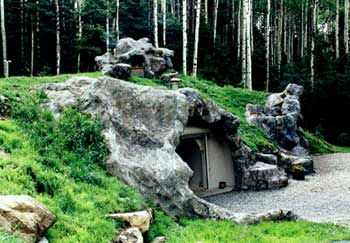earth-sheltered home

An earth-sheltered home, also known simply as an earth home, is a dwelling that is partially or totally underground (see underground home) or that has earth berms around some or all of its exterior walls (see bermed earth-sheltered home).
Earth-sheltered homes can be tailored to a wide range of climates and a variety of types of building sites – even flat ones. Combined with passive solar design, an earth-sheltered home can save tens of thousands of dollars in fuel bills over a lifetime.
Earth-sheltered homes are comfortable, affordable and energy efficient. And, if thoughtfully designed, they allow in plenty of natural light and are far less of an imposition on the landscape than conventional above-ground houses. They also led themselves to innovative ideas in design and, in particular, the use of organic architectures including curving walls and ceilings that are more satisfying and harmonious as human dwellings.
Advantages
There are many advantages to earth-sheltered construction. An earth-sheltered home is less susceptible to the impact of extreme outdoor air temperatures, so the effects of adverse weather are not felt as much as in a conventional house. Temperatures inside an earth-sheltered are more stable than in conventional homes. And with less temperature variability, interior rooms seem more comfortable.
Because earth covers part or all of their exterior, earth-sheltered houses require less outside maintenance, such as painting and cleaning gutters. Constructing a house that is dug into the earth or surrounded by earth builds in some natural soundproofing. Plans for most earth-sheltered houses "blend" the building into the landscape more harmoniously than a conventional home.
Finally, earth-sheltered houses can cost less to insure because their design offers extra protection against high winds, hailstorms, and natural disasters such as tornados and hurricanes.
Disadvantages
As with any type of unusual construction, there are some disadvantages associated with earth-sheltered housing. Principal downsides are the initial cost of construction, which may be up to 20% higher. Also, an increased level of care is required to avoid moisture problems, during both the construction and the life of the house.
It can take more diligence to resell an earth-sheltered home, and buyers may have a few more hurdles to clear in the mortgage application process.
Site-specific factors for earth-sheltered home design
Before deciding to design and build an earth-sheltered house, you need to consider the building site's climate, topography, soil, and groundwater level.
Climate and topography
The climate in your geographical area will determine whether an earth-sheltered house can be a practical housing solution. Studies show that earth-sheltered houses are more cost-effective in climates that have significant temperature extremes and low humidity, such as the Rocky Mountains and northern Great Plains. Earth temperatures vary much less than air temperatures in these areas, which means the earth can absorb extra heat from the house in hot weather or insulate the house to maintain warmth in cold weather.
The site's topography and microclimate determine how easily the building can be surrounded with earth. A modest slope requires more excavation than a steep one, and a flat site is the most demanding, needing extensive excavation. A south-facing slope in a region with moderate to long winters is ideal for an earth-sheltered building. South-facing windows can let in sunlight for direct heating, while the rest of the house is set back into the slope.
In regions with mild winters and predominantly hot summers, a north-facing slope might be ideal. Every site differs, but generally southern exposures offer more sun and daylight throughout the year than north-facing slopes. Most designs can be built to take advantage of each site.
Soil
The type of soil at your site is another critical consideration. Some types of soil are more suitable than others for earth-sheltered construction. For example, the best soils are granular, such as sand and gravel. These soils compact well for bearing the weight of the construction materials and are very permeable, which means they allow water to drain quickly. The poorest soils are cohesive, like clay, which may expand when wet and has poor permeability. Soil tests, offered through professional testing services, can determine load-bearing capability of soils and possible settlements that may occur.
Radon is an invisible and odorless radioactive gas produced naturally when uranium in rock decomposes. It is found in the soil and in outdoor air in harmless amounts, but can reach dangerous levels when trapped. Radon levels are another factor to consider in locating your home. Areas with high concentrations of radon can be hazardous, although there are methods that can reduce radon buildup in both conventional and earth-sheltered dwellings.
Groundwater level
The groundwater level at your building site is another important consideration. Building above the water table is almost essential. Choosing a site where the water will naturally drain away from the building is the best way to avoid water pressure against underground walls. The site should be surveyed for low spots and areas where water will collect. Seasonal or regular surface water flows should be channeled away from the structure. Drainage systems must be designed to draw water away from the structure to reduce the frequency and length of time the water remains in contact with the building's exterior. Underground footing drains similar to or greater than those required by a house with a basement are necessary in many cases.
See also earth-sheltered home construction.
